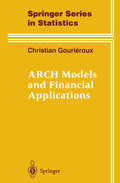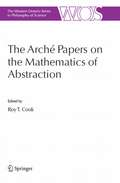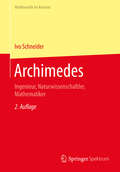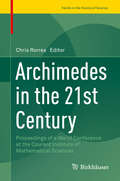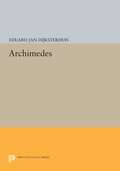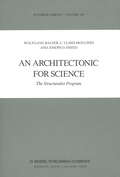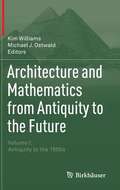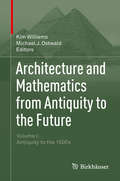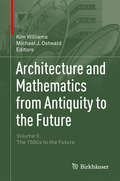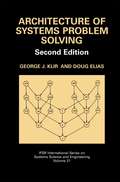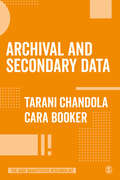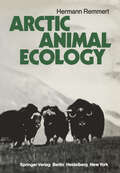- Table View
- List View
ARCH Models for Financial Applications
by Evdokia Xekalaki Stavros DegiannakisAutoregressive Conditional Heteroskedastic (ARCH) processes are used in finance to model asset price volatility over time. This book introduces both the theory and applications of ARCH models and provides the basic theoretical and empirical background, before proceeding to more advanced issues and applications. The Authors provide coverage of the recent developments in ARCH modelling which can be implemented using econometric software, model construction, fitting and forecasting and model evaluation and selection. Key Features: Presents a comprehensive overview of both the theory and the practical applications of ARCH, an increasingly popular financial modelling technique. Assumes no prior knowledge of ARCH models; the basics such as model construction are introduced, before proceeding to more complex applications such as value-at-risk, option pricing and model evaluation. Uses empirical examples to demonstrate how the recent developments in ARCH can be implemented. Provides step-by-step instructive examples, using econometric software, such as Econometric Views and the G@RCH module for the Ox software package, used in Estimating and Forecasting ARCH Models. Accompanied by a CD-ROM containing links to the software as well as the datasets used in the examples. Aimed at readers wishing to gain an aptitude in the applications of financial econometric modelling with a focus on practical implementation, via applications to real data and via examples worked with econometrics packages.
The Arché Papers on the Mathematics of Abstraction (The Western Ontario Series in Philosophy of Science #71)
by Roy T. CookThis volume collects together a number of important papers concerning both the method of abstraction generally and the use of particular abstraction principles to reconstruct central areas of mathematics along logicist lines. Attention is focused on extending the Neo-Fregean treatment to all of mathematics, with the reconstruction of real analysis from various cut- or cauchy-sequence-related abstraction principles and the reconstruction of set theory from various restricted versions of Basic Law V as case studies.
Archimedes: Ingenieur, Naturwissenschaftler, Mathematiker (Mathematik im Kontext)
by Ivo SchneiderEin Meilenstein der Archimedes-Forschung wieder verfügbar! Ausgestattet mit einem umfangreichen neuen Vorwort, das auf die neueren Forschungsergebnisse eingeht, wird in diesem wegweisenden Werk die bis heute ungeklärte Kernfrage der Archimedes-Forschung behandelt: Ist Archimedes von der Praxis des Architekten, Geschütz- und Instrumentenbauers über die Mechanik zur Mathematik gekommen, oder hat er als Mathematiker die Mechanik zu einer mathematischen Disziplin gemacht, für die er später Anwendungen suchte? Über die Rekonstruktion des Lebens und des Werkes von Archimedes werden seine außermathematischen Aktivitäten und Leistungen mit denen des Mathematikers in einen Zusammenhang gebracht und so die z. T. auseinanderstrebende Ergebnisse der Forschung in den letzten Jahrzehnten harmonisiert. Durch seinen stringenten Aufbau führt das Buch bestens in die Biographie und das Werk von Archimedes ein und zeigt dabei auch, welche z. T. großen Erkenntnislücken wir heute noch über Archimedes haben.
Archimedes in the 21st Century: Proceedings of a World Conference at the Courant Institute of Mathematical Sciences (Trends in the History of Science)
by Chris RorresThis book is a collection of papers presented at the “Archimedes in the 21st Century” world conference, held at the Courant Institute of Mathematical Sciences in 2013. This conference focused on the enduring and continuing influence of Archimedes in our modern world, celebrating his centuries of influence on mathematics, science, and engineering. Archimedes planted the seeds for a myriad of seminal ideas that would grow over the ages. Each chapter surveys the growth of one or more of these seeds, and the fruit that they continue to bear to this day. The conference speakers contributing to this book are actively involved in STEM fields whose origins trace back to Archimedes, many of whom have conducted and published research that extends Archimedes’ work into the 21st century. The speakers are not historians, so while historical context is provided, this book is uniquely focused on the works themselves as opposed to their history. The breadth and depth of Archimedes’ influence will inspire, delight, and even surprise readers from a variety of fields and interests including historians, mathematicians, scientists, and engineers. Only a modest background in math is required to read this book, making it accessible to curious readers of all ages.
Archimedes (PDF)
by Eduard Jan DijksterhuisThis classic study by the eminent Dutch historian of science E. J. Dijksterhuis (1892-1965) presents the work of the Greek mathematician and mechanical engineer to the modern reader. With meticulous scholarship, Dijksterhuis surveys the whole range of evidence on Archimedes' life and the 2000-year history of the manuscripts and editions of the text, and then undertakes a comprehensive examination of all the extant writings.Originally published in 1987.The Princeton Legacy Library uses the latest print-on-demand technology to again make available previously out-of-print books from the distinguished backlist of Princeton University Press. These editions preserve the original texts of these important books while presenting them in durable paperback and hardcover editions. The goal of the Princeton Legacy Library is to vastly increase access to the rich scholarly heritage found in the thousands of books published by Princeton University Press since its founding in 1905.
Architecting Cloud Native Serverless Solutions: Design, Build, And Operate Serverless Solutions On Cloud And Open-source Platforms
by Safeer CmArchitecting Cloud-Native Serverless Solutions: Design, Build, And Operate Serverless Solutions On Cloud And Open-source Platforms
by Safeer CmDesign, build, and operate serverless solutions on cloud and open source platforms
Architecting Google Cloud Solutions: Learn to Design Robust and Future-proof Solutions with Google Cloud Technologies
by Victor DantasAchieve your business goals and build highly available, scalable, and secure cloud infrastructure by designing robust and cost-effective solutions as a Google Cloud Architect. Key FeaturesGain hands-on experience in designing and managing high-performance cloud solutionsLeverage Google Cloud Platform to optimize technical and business processes using cutting-edge technologies and servicesUse Google Cloud Big Data, AI, and ML services to design scalable and intelligent data solutionsBook Description Google has been one of the top players in the public cloud domain thanks to its agility and performance capabilities. This book will help you design, develop, and manage robust, secure, and dynamic solutions to successfully meet your business needs. You'll learn how to plan and design network, compute, storage, and big data systems that incorporate security and compliance from the ground up. The chapters will cover simple to complex use cases for devising solutions to business problems, before focusing on how to leverage Google Cloud's Platform-as-a-Service (PaaS) and Software-as-a-Service (SaaS) capabilities for designing modern no-operations platforms. Throughout this book, you'll discover how to design for scalability, resiliency, and high availability. Later, you'll find out how to use Google Cloud to design modern applications using microservices architecture, automation, and Infrastructure-as-Code (IaC) practices. The concluding chapters then demonstrate how to apply machine learning and artificial intelligence (AI) to derive insights from your data. Finally, you will discover best practices for operating and monitoring your cloud solutions, as well as performing troubleshooting and quality assurance. By the end of this Google Cloud book, you'll be able to design robust enterprise-grade solutions using Google Cloud Platform. What you will learnGet to grips with compute, storage, networking, data analytics, and pricingDiscover delivery models such as IaaS, PaaS, and SaaSExplore the underlying technologies and economics of cloud computingDesign for scalability, business continuity, observability, and resiliencySecure Google Cloud solutions and ensure complianceUnderstand operational best practices and learn how to architect a monitoring solutionGain insights into modern application design with Google CloudLeverage big data, machine learning, and AI with Google CloudWho this book is for This book is for cloud architects who are responsible for designing and managing cloud solutions with GCP. You'll also find the book useful if you're a system engineer or enterprise architect looking to learn how to design solutions with Google Cloud. Moreover, cloud architects who already have experience with other cloud providers and are now beginning to work with Google Cloud will benefit from the book. Although an intermediate-level understanding of cloud computing and distributed apps is required, prior experience of working in the public and hybrid cloud domain is not mandatory.
An Architectonic for Science: The Structuralist Program (Synthese Library #186)
by W. Balzer C.U. Moulines J.D. SneedThis book has grown out of eight years of close collaboration among its authors. From the very beginning we decided that its content should come out as the result of a truly common effort. That is, we did not "distribute" parts of the text planned to each one of us. On the contrary, we made a point that each single paragraph be the product of a common reflection. Genuine team-work is not as usual in philosophy as it is in other academic disciplines. We think, however, that this is more due to the idiosyncrasy of philosophers than to the nature of their subject. Close collaboration with positive results is as rewarding as anything can be, but it may also prove to be quite difficult to implement. In our case, part of the difficulties came from purely geographic separation. This caused unsuspected delays in coordinating the work. But more than this, as time passed, the accumulation of particular results and ideas outran our ability to fit them into an organic unity. Different styles of exposition, different ways of formalization, different levels of complexity were simultaneously present in a voluminous manuscript that had become completely unmanageable. In particular, a portion of the text had been conceived in the language of category theory and employed ideas of a rather abstract nature, while another part was expounded in the more conventional set-theoretic style, stressing intui tivity and concreteness.
Architectural and Urban Subsymmetries (Mathematics and the Built Environment #6)
by Jin-Ho ParkThis book focuses on symmetries in the analysis and synthesis of architectural designs. Crucial in the history of architecture, principles of symmetry provided the means to achieve balance and harmony of spatial composition in architecture. Less well known is the importance of symmetry principles in the analysis of the distinct constituents in a contemporary architectural design which may, at first glance, appear disorganized or even random. The revelation of different hierarchical levels wherein various types of symmetry or subsymmetry are superimposed provides a key for deciphering the underlying structure of spatial logic. The interaction between local and global subsymmetries is of particular interest. Operating with symmetry concepts in this manner offers architects, designers and students an explicit method for understanding the symmetrical logics of sophisticated designs and gaining insights into new designs.This book has two complementary objectives: to explore the fundamental principles of architectural composition founded on the algebraic structure of symmetry groups in mathematics and to apply the principles in the analysis and synthesis of architectural and urban designs. By viewing and decomposing architectural and urban designs in this manner, the hidden spatial logic and underlying order in a design become transparent.
Architecture And Design Of Linux Storage Stack: A Comprehensive Guide To The Linux Storage Landscape And Its Well-coordinated Layers
by Muhammad UmerArchitecture and Design of the Linux Storage Stack: A Comprehensive Guide To The Linux Storage Landscape And Its Well-coordinated Layers
by Muhammad UmerGain a deep understanding of the Linux storage landscape and its well-coordinated layers
Architecture And Mathematics From Antiquity To The Future: Volume I: Antiquity To The 1500s (PDF)
by Michael J. Ostwald Kim WilliamsEvery age and every culture has relied on the incorporation of mathematics in their works of architecture to imbue the built environment with meaning and order. Mathematics is also central to the production of architecture, to its methods of measurement, fabrication and analysis. This two-volume edited collection presents a detailed portrait of the ways in which two seemingly different disciplines are interconnected. Over almost 100 chapters it illustrates and examines the relationship between architecture and mathematics. Contributors of these chapters come from a wide range of disciplines and backgrounds: architects, mathematicians, historians, theoreticians, scientists and educators. Through this work, architecture may be seen and understood in a new light, by professionals as well as non-professionals. Volume I covers architecture from antiquity through Egyptian, Mayan, Greek, Roman, Medieval, Inkan, Gothic and early Renaissance eras and styles. The themes that are covered range from symbolism and proportion to measurement and structural stability. From Europe to Africa, Asia and South America, the chapters span different countries, cultures and practices.
Architecture And Mathematics From Antiquity To The Future: Volume I: Antiquity To The 1500s
by Michael J. Ostwald Kim Williamsvery age and every culture has relied on the incorporation of mathematics in their works of architecture to imbue the built environment with meaning and order. Mathematics is also central to the production of architecture, to its methods of measurement, fabrication and analysis. This two-volume edited collection presents a detailed portrait of the ways in which two seemingly different disciplines are interconnected. Over almost 100 chapters it illustrates and examines the relationship between architecture and mathematics. Contributors of these chapters come from a wide range of disciplines and backgrounds: architects, mathematicians, historians, theoreticians, scientists and educators. Through this work, architecture may be seen and understood in a new light, by professionals as well as non-professionals. Volume I covers architecture from antiquity through Egyptian, Mayan, Greek, Roman, Medieval, Inkan, Gothic and early Renaissance eras and styles. The themes that are covered range from symbolism and proportion to measurement and structural stability. From Europe to Africa, Asia and South America, the chapters span different countries, cultures and practices.
Architecture and Mathematics from Antiquity to the Future: Volume I: Antiquity to the 1500s
by Kim Williams Michael J. OstwaldEvery age and every culture has relied on the incorporation of mathematics in their works of architecture to imbue the built environment with meaning and order. Mathematics is also central to the production of architecture, to its methods of measurement, fabrication and analysis. This two-volume edited collection presents a detailed portrait of the ways in which two seemingly different disciplines are interconnected. Over almost 100 chapters it illustrates and examines the relationship between architecture and mathematics. Contributors of these chapters come from a wide range of disciplines and backgrounds: architects, mathematicians, historians, theoreticians, scientists and educators. Through this work, architecture may be seen and understood in a new light, by professionals as well as non-professionals.Volume I covers architecture from antiquity through Egyptian, Mayan, Greek, Roman, Medieval, Inkan, Gothic and early Renaissance eras and styles. The themes that are covered range from symbolism and proportion to measurement and structural stability. From Europe to Africa, Asia and South America, the chapters span different countries, cultures and practices.
Architecture and Mathematics from Antiquity to the Future: Volume II: The 1500s to the Future
by Kim Williams Michael J. OstwaldEvery age and every culture has relied on the incorporation of mathematics in their works of architecture to imbue the built environment with meaning and order. Mathematics is also central to the production of architecture, to its methods of measurement, fabrication and analysis. This two-volume edited collection presents a detailed portrait of the ways in which two seemingly different disciplines are interconnected. Over almost 100 chapters it illustrates and examines the relationship between architecture and mathematics. Contributors of these chapters come from a wide range of disciplines and backgrounds: architects, mathematicians, historians, theoreticians, scientists and educators. Through this work, architecture may be seen and understood in a new light, by professionals as well as non-professionals.Volume II covers architecture from the Late Renaissance era, through Baroque, Ottoman, Enlightenment, Modern and contemporary styles and approaches. Key figures covered in this volume include Palladio, Michelangelo, Borromini, Sinan, Wren, Wright, Le Corbusier, Breuer, Niemeyer and Kahn. Mathematical themes which are considered include linear algebra, tiling and fractals and the geographic span of the volume’s content includes works in the United States of America and Australia, in addition to those in Europe and Asia.
Architecture of Mathematics
by Simon SerovajskyArchitecture of Mathematics describes the logical structure of Mathematics from its foundations to its real-world applications. It describes the many interweaving relationships between different areas of mathematics and its practical applications, and as such provides unique reading for professional mathematicians and nonmathematicians alike. This book can be a very important resource both for the teaching of mathematics and as a means to outline the research links between different subjects within and beyond the subject. Features All notions and properties are introduced logically and sequentially, to help the reader gradually build understanding. Focusses on illustrative examples that explain the meaning of mathematical objects and their properties. Suitable as a supplementary resource for teaching undergraduate mathematics, and as an aid to interdisciplinary research. Forming the reader's understanding of Mathematics as a unified science, the book helps to increase his general mathematical culture.
Architecture of Mathematics
by Simon SerovajskyArchitecture of Mathematics describes the logical structure of Mathematics from its foundations to its real-world applications. It describes the many interweaving relationships between different areas of mathematics and its practical applications, and as such provides unique reading for professional mathematicians and nonmathematicians alike. This book can be a very important resource both for the teaching of mathematics and as a means to outline the research links between different subjects within and beyond the subject. Features All notions and properties are introduced logically and sequentially, to help the reader gradually build understanding. Focusses on illustrative examples that explain the meaning of mathematical objects and their properties. Suitable as a supplementary resource for teaching undergraduate mathematics, and as an aid to interdisciplinary research. Forming the reader's understanding of Mathematics as a unified science, the book helps to increase his general mathematical culture.
The Architecture of Scientific Software: IFIP TC2/WG2.5 Working Conference on the Architecture of Scientific Software October 2–4, 2000, Ottawa, Canada (IFIP Advances in Information and Communication Technology #60)
by Ronald F. Boisvert Ping Tak Peter TangScientific applications involve very large computations that strain the resources of whatever computers are available. Such computations implement sophisticated mathematics, require deep scientific knowledge, depend on subtle interplay of different approximations, and may be subject to instabilities and sensitivity to external input. Software able to succeed in this domain invariably embeds significant domain knowledge that should be tapped for future use. Unfortunately, most existing scientific software is designed in an ad hoc way, resulting in monolithic codes understood by only a few developers. Software architecture refers to the way software is structured to promote objectives such as reusability, maintainability, extensibility, and feasibility of independent implementation. Such issues have become increasingly important in the scientific domain, as software gets larger and more complex, constructed by teams of people, and evolved over decades. In the context of scientific computation, the challenge facing mathematical software practitioners is to design, develop, and supply computational components which deliver these objectives when embedded in end-user application codes. The Architecture of Scientific Software addresses emerging methodologies and tools for the rational design of scientific software, including component integration frameworks, network-based computing, formal methods of abstraction, application programmer interface design, and the role of object-oriented languages. This book comprises the proceedings of the International Federation for Information Processing (IFIP) Conference on the Architecture of Scientific Software, which was held in Ottawa, Canada, in October 2000. It will prove invaluable reading for developers of scientific software, as well as for researchers in computational sciences and engineering.
Architecture of Systems Problem Solving (IFSR International Series in Systems Science and Systems Engineering #21)
by George J. Klir Doug EliasOne criterion for classifying books is whether they are written for a single pur pose or for multiple purposes. This book belongs to the category of multipurpose books, but one of its roles is predominant-it is primarily a textbook. As such, it can be used for a variety ofcourses at the first-year graduate or upper-division undergraduate level. A common characteristic of these courses is that they cover fundamental systems concepts, major categories of systems problems, and some selected methods for dealing with these problems at a rather general level. A unique feature of the book is that the concepts, problems, and methods are introduced in the context of an architectural formulation of an expert system referred to as the general systems problem solver or aSPS-whose aim is to provide users ofall kinds with computer-based systems knowledge and methodo logy. Theasps architecture,which is developed throughout the book, facilitates a framework that is conducive to acoherent, comprehensive, and pragmaticcoverage ofsystems fundamentals-concepts, problems, and methods. A course that covers systems fundamentals is now offered not only in sys tems science, information science, or systems engineering programs, but in many programs in other disciplines as well. Although the level ofcoverage for systems science or engineering students is surely different from that used for students in other disciplines, this book is designed to serve both of these needs.
Archival and Secondary Data (The SAGE Quantitative Research Kit)
by Tarani Chandola Cara BookerData archives provide rich and expansive sources of information for researchers. This book highlights the utility of secondary data analyses whilst showing you how to select the right datasets for your study, and in turn get the most out of your research. Topics include: · Generating your research question · Selecting appropriate datasets and variables · Examining univariate, bivariate and multivariate associations · Visualisng your data with tables and graphs Part of The SAGE Quantitative Research Kit, this book boosts students with know-how and confidence, to help them succeed on their quantitative research journey.
Archival and Secondary Data (The SAGE Quantitative Research Kit)
by Tarani Chandola Cara BookerData archives provide rich and expansive sources of information for researchers. This book highlights the utility of secondary data analyses whilst showing you how to select the right datasets for your study, and in turn get the most out of your research. Topics include: · Generating your research question · Selecting appropriate datasets and variables · Examining univariate, bivariate and multivariate associations · Visualisng your data with tables and graphs Part of The SAGE Quantitative Research Kit, this book boosts students with know-how and confidence, to help them succeed on their quantitative research journey.
Archival and Secondary Data (The SAGE Quantitative Research Kit)
by Tarani Chandola Cara BookerData archives provide rich and expansive sources of information for researchers. This book highlights the utility of secondary data analyses whilst showing you how to select the right datasets for your study, and in turn get the most out of your research. Topics include: · Generating your research question · Selecting appropriate datasets and variables · Examining univariate, bivariate and multivariate associations · Visualisng your data with tables and graphs Part of The SAGE Quantitative Research Kit, this book boosts students with know-how and confidence, to help them succeed on their quantitative research journey.
Arctic Animal Ecology
by Hermann RemmertA large number of comprehensive publications has been devoted to the Antarctic, to its plant and animal life. It is therefore relatively easy to familiarize oneself with the current state of Antarctic research. Nothing comparable is available for the Arctic. The heterogeneity and richness of the northern polar regions seem to have discouraged any attempt at a synthethic approach. This book has evolved from an attempt to summarize the results of 15 years of ecological and physiological research work in the Arctic - mostly on Spitsbergen. The necessity of comparing our results and the ecological conditions of Spitsbergen with other arctic regions grew into a full-sized book on arctic animal ecology. It is not meant as an exhaustive survey ofthe relevant literature. Instead I have tried to show how closely the various fields of research are interwoven, how many questions can be solved if only notice is taken of fellow scientists and their results, and how much arctic animals have in common. This book would not have been possible without the helpfulness of many colleagues. Above all I should like to mention Professor Ronning and Professor Solem of Trondheim University (Norway), Professor Arnthor Gardasson of Reykjavik University (Iceland), Dr. NettIeship, Dr. Oliver and Dr. Ryder of Canada and Professor West of Fairbanks University (Alaska, USA).
